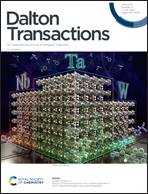Merging of the photocatalyst decatungstate and naphthalene diimide in a hybrid structure for the oxidative coupling of amines†
Abstract
Designing and developing novel hybrid materials for the effective photoconversion of organic substrates is of great importance. Crystalline hybrid heterostructures, as an attractive class of material, are composed of semiconducting organic and inorganic components with fast-responsive charge-separated properties and thus they are promising photocatalysts. Naphthalene diimides (NDIs) and decatungstate (W10O324−) are two versatile semiconductor components that have been utilized as building blocks for the construction of functional materials for various applications. In this context, we demonstrated that the combination of an electron-deficient NDI derivative with W10O324− resulted in an organic–inorganic hybrid compound, namely Zn2(DPNDI)(W10O32)(DMA)6 (DPNDI = N,N′-di-(4-pyridyl)-1,4,5,8-naphthalene diimide) (1). Because of consecutive photo-induced electron transfer processes among the components, this hybrid compound exhibits fast-responsive reversible photochromic properties, and it efficiently photocatalytically oxidizes amines to imines under mild conditions with high yields and an excellent substrate application range.



 Please wait while we load your content...
Please wait while we load your content...